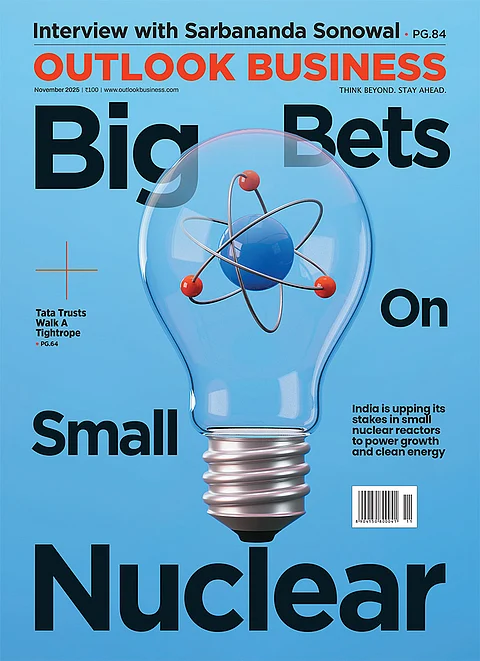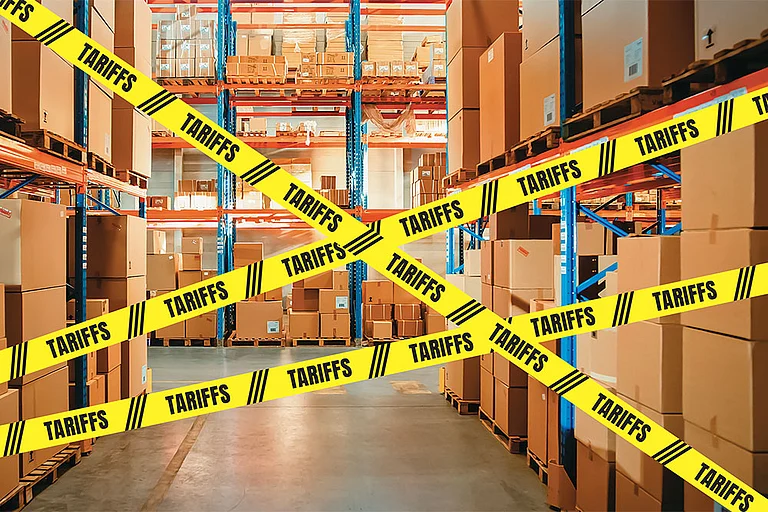
US tariffs of 50% threaten 66% of India’s $86.5bn exports.
Labour-intensive sectors like textiles, gems and shrimp face up to 70% export collapse.
Competitors Vietnam, Ecuador, Turkey and Bangladesh gain edge with lower tariff exposure.
GTRI warns India’s US exports may drop 43% to $49.6bn in FY26.
From 27 August, certain Indian exports to the United States came under a 50% tariff. In addition, India faced an extra 25% levy for being the second-largest buyer of Russian crude—a penalty that China, the top importer, managed to avoid so far.
The tariff, effective from today, threatens 66% of India’s $86.5bn exports to Washington, which is $60.2bn worth of goods. Labour-intensive sectors like textiles, gems and shrimp are at higher risk and are also bracing for a 70% export collapse.
"India’s exports to the US are set to fall steeply—from $86.5bn in FY2025 to about $49.6bn in FY2026—due to Washington’s new tariff regime," New Delhi-based policy think tank, Global Trade Research Initiative (GTRI), said in a recent report. Detailing more on the impact, it added that 30% of exports, totalling $27.6bn, will remain duty-free and 4% worth $3.4bn, mainly comprising auto parts, will face a 25% tariff. Exports from these sectors could plunge 70%, dropping to $18.6bn, causing an overall 43% decline in shipments to the US and endangering hundreds of thousands of jobs.
Barclays Research, in a report titled 'India-US tariff update: When worst fears come true' highlighted that on a trade-weighted basis, India's tariffs average at 35.7%, as compared to 2.7% before tariffs, while its tariffs on US imports remain at 9.4%, underscoring the asymmetry.Fxe
Worst Hit Sectors & Top Competitors
India's peers like Vietnam export $120bn to the US, or 26% of its GDP, but it only has 20% tariffs. China export $525bn to the US, with not only 30% tariffs but also under an extended tariff pause currently. Indonesia, Malaysia, and Thailand face tariffs of 19%, less than half India’s rate.
India's worst-hit sectors from US tariffs are those where the US accounts for over 30% of India’s global exports, predominantly labour-intensive industries, which now face 70–80% expected declines in annual exports.
Among them are-
A) Shrimp: Last year, total seafood exports from India globally stood at $7.4bn, with shrimp accounting for 40%. India exported $2.4bn worth of shrimps to the US in FY2025, accounting for 32.4% of total shrimp exports. The US previously had 0% most favoured nation (MFN) tariffs and 10% countervailing tariffs. With the new 50% tariff, total duties rise to 60%.
Most of India's shrimp exports to the US are covered by Andhra Pradesh. GTRI noted that exporter purchase prices in the state dropped nearly 20% after the first 25% tariff in early August, pushing many farmers to the brink of losses. The impact is cascading across the supply chain as farm-gate prices in West Godavari and Ongole have plunged by ₹40–₹60/kg for small-count shrimp, making farming uneconomical, it added.
By comparison, Ecuador, India's main rival for shrimp exports to the US, faces a much lower 15% tariff, heightening its competitive edge.
B) Gems, Gold and Jewellery: The US buys close to 30% of India’s gems and jewellery exports, worth around $10 billion annually. Tariffs in this sector will now jump from 2.1% to 50%.
GTRI further notes that Surat’s diamond hub, which employs 1.2mn workers, is already seeing shrinking margins and order cancellations, while Mumbai’s SEEPZ SEZ—where 85% of jewellery exports go to the US—risks 50,000 jobs. Jaipur’s coloured-stone SEZ faces similar pressure, with industry associations warning that 35,000 jobs could vanish if demand does not recover, it added.
According to a Business Standard report, representatives of the sector met senior Reserve Bank of India (RBI) officials virtually earlier this week and requested for additional loan facilities if needed, since the workforce could be severely impacted due to payment delays.
As American buyers diversify, Israel and Belgium are emerging as key sources for natural diamonds, China for lab-grown stones, and Italy, Thailand, Vietnam, Türkiye, the UAE and Mexico for finished jewellery.
C) Textiles and Apparel: India’s textiles and apparel exports to the US stood at $10.8bn in FY25, with apparel alone making $5.4bn, contributing to 35% of India’s apparel exports. Tariffs have now surged from 13.9% to 63.9%, effectively shutting Indian garments out of their largest market, given that margins were already in single digits.
"Exporters have front-loaded shipments ahead of the deadline, but consider the government’s temporary 11% cotton duty waiver (Aug 19–Sept 30) insufficient to offset the loss," said Ajay Srivastava, GTRI's founder.
Key hubs are already under stress. Tiruppur is rushing shipments while cancelling new styles, Noida–Gurugram has halted expansion plans, Ludhiana is hit by falling yarn and fabric demand and Bengaluru units are bracing for shift cuts, the report said.
Meanwhile, US buyers are rapidly reconfiguring supply chains—Bangladesh and Vietnam are absorbing basics, denim and MMF programmes, Pakistan is gaining in denim and fleece, Cambodia is emerging in fast-fashion knits, and Mexico along with CAFTA-DR countries are expanding near-shore replenishment, it noted.
D) Carpets: The US is the largest market for Indian carpets and rugs with 58% share in exports totalling $1.2bn last year. Tariffs on this sector grew from 2.9% to 52.9%, the report highlighted, threatening artisanal livelihoods in Srinagar, Bhadohi and Mirzapur.
"Larger firms are exploring new markets in the Middle East and Europe, product diversification into synthetic rugs, and offshore machine-made production in Turkey or Egypt to maintain US access. However, for traditional hand-knotted producers, relocation is not an option due to the highly specialised and localised nature of their craft," Srivastava highlighted.
US buyers are already shifting to Turkey and China, along with Turkish-owned mills in Egypt, expected to capture demand for machine-made and tufted rugs. In hand-knotted rugs, Turkey is set to strengthen its lead, while Pakistan and Nepal may fill niche segments threatening India's historical dominance.
E) Handicraft: India's handicraft market is also heavily dependent on the US with $1.6bn exports and 40% share in total exports. Due to higher tariffs, it is expected that now Vietnam and China will capture most of the wooden furniture and décor segment while Turkey, Thailand, and UAE will gain in metal décor and lighting.
F) Leather and Shoes: Exports of leather and footwear to the US stood at nearly $1.2 bn in FY2025, or 20% of India’s global shipments in the sector. Export clusters in this segment are under tremendous pressure. Order cancellations from major hubs like Agra and Kanpur are triggering layoff concerns. GTRI said that larger firms are weighing relocation to Vietnam, Indonesia, Cambodia or Mexico to retain US access, while keeping Indian units focused on non-US markets.
"Vietnam, China, Indonesia, and Cambodia are set to take over sneakers and synthetic footwear, Italy and Mexico will fill high-end leather niches, and Bangladesh and Pakistan will expand in basic leather and non-leather products," the report noted.
Meanwhile, industry bodies are pushing for diversification into EU, UK, and Gulf markets and exploring “Made in Europe” partnerships to retain competitiveness in the US market.
G) Furniture and Bedding: The US had a share of nearly 45% in this sector in FY25, making up to $1.1bn in exports. With tariffs rising from 2.3% to 52.3%, while mattresses are already under US anti-dumping duties since 2024, the sector will lose edge against competitors like Vietnam and China, which already hold 60% of the US furniture imports. For bedding and home textiles, Pakistan, China, Turkey, and Vietnam are poised to replace Indian suppliers, while Vietnam, Indonesia, Mexico, and China will dominate mattresses and boxed foam products, said GTRI.
H) Agriculture, meat and processed food: Last but not least comes the agriculture, meat and processed food sector, which contains items like basmati rice, spices, tea, pulses, and sesame. Pakistan appears to be a clear winner in the basmati rice segment, with just a 19% tariff against India's 50% while Thailand and Vietnam could capture the non-basmati demand. On the other hand, Vietnam leads in spices, Kenya and Sri Lanka in tea, Canada in pulses, and Guatemala/Mexico/Nigeria in sesame. U.S. domestic rice producers are also expected to regain share.
"The US tariffs present a formidable challenge, but not an insurmountable one. India’s large domestic market, robust services sector, and expanding trade partnerships offer strong buffers against external shocks," noted Srivastava.

































